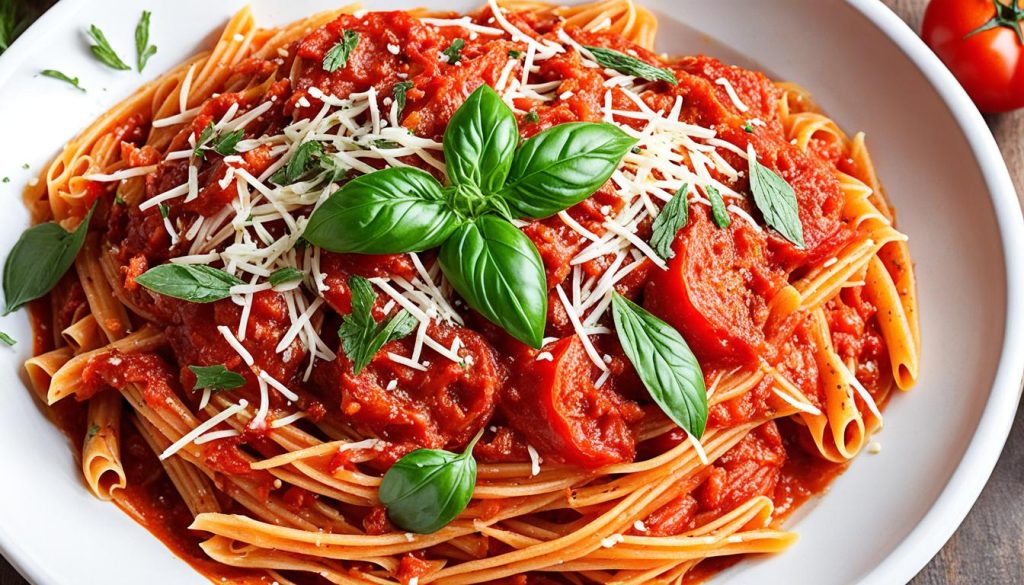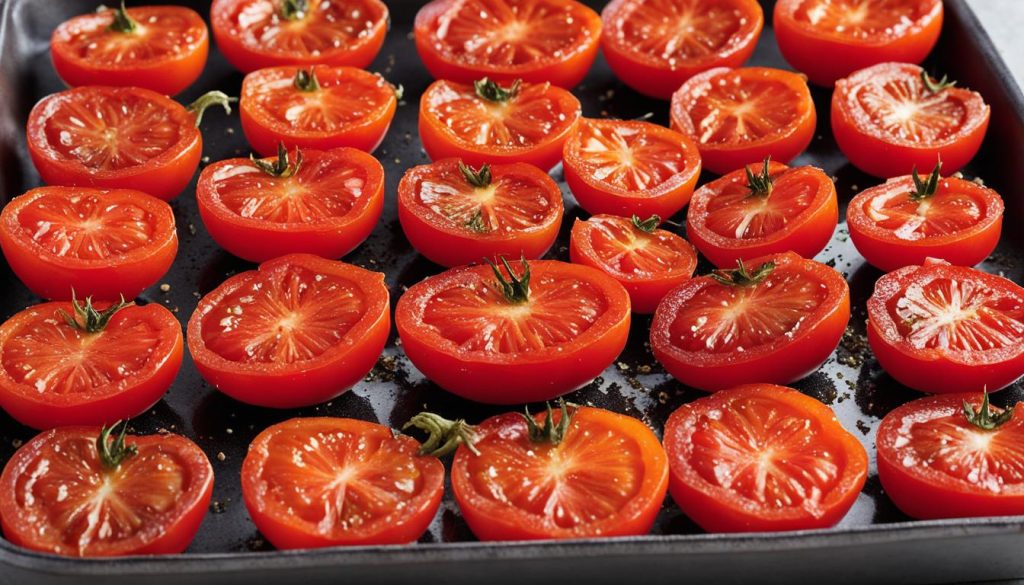Are you tired of store-bought pasta sauce that lacks flavor? Why settle for less when you can create your own homemade tomato sauce from scratch? With fresh ingredients straight from your garden, you can make garden-fresh tomato pasta sauces that will elevate your pasta dishes to new heights. Say goodbye to bland and hello to delicious!
Our homemade pasta sauce recipe delivers a rich and savory flavor that will have you craving seconds. It starts with ripe garden tomatoes, which are the star of the show. Don’t worry if you don’t have a garden, you can also use fresh tomatoes from your local farmers’ market.
As you simmer the tomatoes with aromatic spices like garlic, onion, basil, and oregano, your kitchen will be filled with an irresistible aroma. The addition of olive oil, mushrooms, and soy sauce brings depth and richness to the sauce, taking it to the next level. And if you prefer a touch of sweetness, a pinch of brown sugar does the trick.
But why stop there? You can customize your homemade tomato sauce to your heart’s content. Add meatballs, beef short ribs, ground turkey, or Italian sausage for a meaty twist. For a burst of freshness, toss in some red bell peppers, green bell peppers, carrots, or zucchini. The possibilities are endless, and it’s all about creating a sauce that suits your taste.
Do you want to intensify the flavor of your sauce? One reader suggests roasting the tomatoes before making the sauce. This simple technique concentrates the tomatoes’ natural sugars, resulting in a more intense tomato flavor.
Now that you’ve created a batch of homemade tomato pasta sauce, it’s time to enjoy it. Pour it over your favorite pasta, sprinkle with Parmesan cheese, and savor every bite. And the best part? You can store any leftover sauce for future meals. Refrigerate it for a few days or freeze it for up to six months. A homemade tomato sauce made with love is always worth the effort!
So why settle for store-bought when you can savor the freshness and flavor of homemade garden-fresh tomato pasta sauces? Try our recipe today and elevate your pasta dishes to a whole new level. Your taste buds will thank you!
Choosing the Right Tomatoes for Homemade Pasta Sauce
When it comes to making homemade pasta sauce with fresh tomatoes, selecting the right variety is key to achieving a delicious and flavorful result. Different tomatoes have distinct flavors and textures that can significantly impact the overall taste of your sauce.
Plum tomatoes, such as Roma or San Marzano, are popular choices for garden-fresh tomato sauce. Known for their meaty texture and lower water content, they provide a rich and robust base for your sauce. With fewer seeds and a higher flesh-to-juice ratio, these tomatoes are perfect for cooking down into a thick and flavorful sauce.
Heirloom tomatoes
If you’re looking to add a unique and complex flavor profile to your tomato sauce from scratch, consider using heirloom tomatoes. These tomatoes come in a variety of colors with flavors ranging from sweet to tangy. Experimenting with different heirloom varieties can yield exciting and vibrant results that will elevate your pasta sauce.
Cherry or grape tomatoes
For a touch of sweetness in your fresh tomato pasta sauce, try adding cherry or grape tomatoes. These small tomatoes pack a punch of flavor and can add a delightful burst of sweetness to your sauce. Simply halve them to release their juicy goodness into the mix.
When choosing the right tomatoes for your sauce, consider the balance of sweetness and acidity that you desire. Taste as you go and adjust accordingly to achieve the perfect flavor profile for your palate.
The Secret Ingredient: Soy Sauce for Richness

When it comes to elevating your homemade pasta sauce to the next level, there’s a secret ingredient that can add a rich and meaty flavor: soy sauce. It may sound surprising, but trust us, it works like magic.
By adding soy sauce to the chopped mushrooms in your sauce, you’ll intensify their flavor and enhance the overall depth of the sauce. Don’t worry, the soy sauce won’t make your sauce taste strange or overpowering. Instead, it brings out the flavors in a delightful way, giving your sauce a unique and savory twist.
Next time you’re preparing your homemade marinara or tomato sauce from scratch, be sure to give this tip a try. You’ll be amazed at the difference it makes in the final dish.
Now, let’s move on to the next section where we’ll explore how to enhance your homemade pasta sauce with delicious vegetables.
Enhancing Homemade Pasta Sauce with Vegetables
For those who prefer a chunky pasta sauce, you can add a variety of vegetables to the sauce. Adding vegetables not only enhances the flavor but also adds a nutritious twist. Here are some vegetables you can consider:
- Red bell pepper: Adds sweetness and a vibrant color to the sauce.
- Green bell pepper: Provides a subtle tang and texture.
- Shredded or finely chopped carrots: Adds a touch of sweetness and a natural richness.
- Red pepper flakes: Introduces a spicy kick for those who love a little heat.
- Zucchini: Brings a mild flavor and a pleasant crunch to the sauce.
By incorporating these vegetables into your homemade pasta sauce, you’ll create a sauce that is not only flavorful but also packed with added nutrients. Feel free to experiment with different combinations of vegetables to find your perfect blend.
Roasting Tomatoes for Intensified Flavor

One reader suggests roasting fresh tomatoes before using them in homemade pasta sauce. Roasting the tomatoes concentrates their natural sugars and intensifies their flavor. To roast tomatoes, follow these steps:
- Cut the tomatoes in half.
- Remove as much of the seeds/gel as possible into a strainer.
- Place the tomato halves cut side down on a large cookie pan covered with parchment paper.
- Roast at 350-400 degrees until the skins start turning color.
- Remove the tray from the oven and drain the liquid from the tomatoes into the strainer.
- Allow the roasted tomatoes to cool before removing the skins.
The roasted tomatoes can now be added to your homemade pasta sauce, enhancing its taste with a deliciously concentrated flavor.
Using San Marzano Tomatoes as an Alternative
If fresh garden tomatoes are not available, San Marzano tomatoes are considered the best alternative. These tomatoes are often used in Italian cooking and are known for their sweet, low-acid flesh. When using San Marzano tomatoes, opt for whole tomatoes rather than crushed tomatoes for a better texture. Simply mash the whole tomatoes with a potato masher as the sauce cooks down to achieve the desired consistency.
San Marzano tomatoes are a great choice for your homemade pasta sauce when garden-fresh tomatoes are out of season. These tomatoes originate from the volcanic soils near Mount Vesuvius in Italy, and their unique flavor profile adds depth and richness to your sauce.
To further enhance the taste of your pasta sauce, consider pairing San Marzano tomatoes with aromatic herbs such as fresh basil, oregano, or thyme. These herbs complement the natural sweetness of the tomatoes and infuse the sauce with delightful flavors.
By using San Marzano tomatoes as an alternative, you can still create a delicious and authentic homemade pasta sauce with an unmistakable Italian touch.
This image illustrates a delicious homemade pasta sauce made with San Marzano tomatoes, showcasing the richness and vibrant color of the sauce.
Advantages of Using San Marzano Tomatoes:
- Distinct flavor: San Marzano tomatoes have a sweet, rich taste that elevates your pasta sauce to new heights.
- Low acidity: The low acidity of San Marzano tomatoes makes them easier on the stomach and reduces the need for added sugar.
- Meaty texture: The flesh of San Marzano tomatoes is firm and densely packed, resulting in a sauce with a satisfying texture.
- Authenticity: San Marzano tomatoes are a staple in Italian cuisine, and using them in your sauce adds an authentic touch to your homemade creations.
Whether you’re creating a classic marinara sauce or experimenting with different flavors, San Marzano tomatoes are a versatile ingredient that brings exceptional taste and quality to your homemade pasta sauce.
Tips to Thicken Homemade Pasta Sauce
The key to achieving a thick and flavorful homemade pasta sauce is simmering it for a longer duration. As the sauce simmers, the liquid will gradually evaporate, resulting in a thicker consistency.
If you find that your sauce needs to be thickened further or at a faster pace, there are a few techniques you can try:
- Adding Tomato Paste: Tomato paste is a concentrated form of tomatoes and can quickly thicken your sauce. Start by adding about a tablespoon of tomato paste at a time and stir it well into the sauce. Repeat this process until you reach the desired thickness.
- Blending Chunks of Tomatoes: Another method to add thickness to your sauce is by blending chunks of tomatoes. Use an immersion blender to puree some of the sauce, creating a thicker texture. Add the blended tomatoes back into the sauce, and continue simmering to incorporate the flavors.
Remember, slow and steady simmering allows the flavors to develop and ensures a rich and satisfying pasta sauce.
Storing Homemade Pasta Sauce
After enjoying a delicious homemade pasta sauce, you may find yourself with leftovers that you want to preserve. Fortunately, there are a few storage options available to ensure your sauce stays fresh and flavorful.
If you have extra homemade pasta sauce, you can refrigerate it for about three to four days. Simply transfer the sauce to an airtight container and place it in the refrigerator. This way, you can easily use it for future meals.
For longer-term storage, freezing is a great option. Before freezing the sauce, make sure it cools down completely to prevent condensation and freezer burn. It’s best to use freezer-safe containers or bags to avoid any unwanted leaks. Leave some space at the top of the container or bag to allow for expansion as the sauce freezes.
Another method for long-term storage is canning the sauce. This is a great option if you want to enjoy your homemade pasta sauce throughout the year. To can the sauce, add citric acid or lemon juice for acidity, as this helps preserve the sauce. Sterilize the jars, fill them with the sauce, and process them in a boiling water bath for at least 10 minutes. This will ensure the sauce remains safe and delicious for an extended period.
Remember to label your stored sauce with the date to keep track of its freshness. Whether you choose to refrigerate, freeze, or can your homemade pasta sauce, you’ll have a ready-made option for quick and delicious meals in the future.
Conclusion
Homemade pasta sauces using garden-fresh tomatoes are a delicious and customizable option for pasta lovers. By utilizing fresh ingredients and simple techniques, you can create a rich and flavorful sauce that surpasses store-bought alternatives. The possibilities are endless when it comes to adding meat, vegetables, or herbs to your sauce. Experiment with different tomato varieties and cooking methods to find the perfect combination that satisfies your taste buds.
With a little time and effort, you can savor the taste of summer all year round with homemade tomato pasta sauces. Whether you prefer a traditional marinara sauce or a creamy tomato basil sauce, the freshness and quality of homemade sauce will elevate your pasta dishes to new heights.
So why settle for mediocre when you can indulge in the authentic flavors of homemade pasta sauce? Take control of your culinary creations and impress your family and friends with the delectable taste of garden-fresh tomato pasta sauces. It’s time to unleash your creativity in the kitchen and enjoy the satisfying rewards of homemade goodness. Start experimenting today and discover the joy of homemade tomato pasta sauces!







